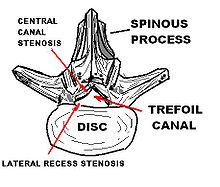| Spinal stenosis | |
|---|---|
 | |
| Spinal stenosis | |
| Specialty | Orthopedics, neurosurgery |
| Symptoms | Pain, numbness, or weakness in the arms or legs[1] |
| Complications | Loss of bladder control, loss of bowel control, sexual dysfunction[1] |
| Usual onset | Gradual[1] |
| Types | Cervical, thoracic, lumbar[2] |
| Causes | Osteoarthritis, rheumatoid arthritis, spinal tumors, trauma, Paget's disease of the bone, scoliosis, spondylolisthesis, achondroplasia[3] |
| Diagnostic method | Based on symptoms and medical imaging[4] |
| Differential diagnosis | Cauda equina syndrome, osteomylitis, peripheral vascular disease, fibromyalgia[5] |
| Treatment | Medications, exercises, bracing, surgery.[6] |
| Medication | straightening of cervical spine non steroid anti inflammatory phsiopedia.com drugs NSAIDs, acetaminophen, steroid injections[7] |
| Frequency | Up to 8% of people[4] |
Spinal stenosis is an abnormal narrowing of the spinal canal or neural foramen that results in pressure on the spinal cord or nerve roots.[6] Symptoms may include pain, numbness, or weakness in the arms or legs.[1] Symptoms are typically gradual in onset and improve with leaning forward.[1] Severe symptoms may include loss of bladder control, loss of bowel control, or sexual dysfunction.[1]
Causes may include osteoarthritis, rheumatoid arthritis, spinal tumors, trauma, Paget's disease of the bone, scoliosis, spondylolisthesis, and the genetic condition achondroplasia.[3] It can be classified by the part of the spine affected into cervical, thoracic, and lumbar stenosis.[2] Lumbar stenosis is the most common, followed by cervical stenosis.[2] Diagnosis is generally based on symptoms and medical imaging.[4]
Treatment may involve medications, bracing, or surgery.[6] Medications may include NSAIDs, acetaminophen, anticonvulsants (gabapentinoids) or steroid injections.[8][7] Stretching and strengthening exercises may also be useful.[1] Limiting certain activities may be recommended.[6] Surgery is typically only done if other treatments are not effective, with the usual procedure being a decompressive laminectomy.[7]
Spinal stenosis occurs in as many as 8% of people.[4] It occurs most commonly in people over the age of 50.[9] Males and females are affected equally often.[10] The first modern description of the condition is from 1803 by Antoine Portal, and there is evidence of the condition dating back to Ancient Egypt.[11]
- ^ a b c d e f g "Spinal Stenosis". National Institute of Arthritis and Musculoskeletal and Skin Diseases. 11 April 2017. Retrieved 19 December 2017.
- ^ a b c Canale ST, Beaty JH (2012). Campbell's Operative Orthopaedics E-Book. Elsevier Health Sciences. p. 1994. ISBN 978-0323087186.
- ^ a b "Spinal Stenosis". National Institute of Arthritis and Musculoskeletal and Skin Diseases. 11 April 2017. Retrieved 19 December 2017.
- ^ a b c d Domino FJ (2010). The 5-Minute Clinical Consult 2011. Lippincott Williams & Wilkins. p. 1224. ISBN 9781608312597.
- ^ Ferri FF (2017). Ferri's Clinical Advisor 2018 E-Book: 5 Books in 1. Elsevier Health Sciences. p. 1202. ISBN 9780323529570.
- ^ a b c d "Spinal Stenosis". National Institute of Arthritis and Musculoskeletal and Skin Diseases. 11 April 2017. Retrieved 19 December 2017.
- ^ a b c "Spinal Stenosis". National Institute of Arthritis and Musculoskeletal and Skin Diseases. 11 April 2017. Retrieved 19 December 2017.
- ^ Kwon, Ji-won; Moon, Seong-Hwan; Park, Si-Young; Park, Sang-Jun; Park, Sub-Ri; Suk, Kyung-Soo; Kim, Hak-Sun; Lee, Byung Ho (2022-10-31). "Lumbar Spinal Stenosis: Review Update 2022". Asian Spine Journal. 16 (5). Asian Spine Journal (ASJ): 789–798. doi:10.31616/asj.2022.0366. ISSN 1976-1902. PMC 9633250. PMID 36266248. S2CID 253043954.
- ^ "Spinal Stenosis". National Institute of Arthritis and Musculoskeletal and Skin Diseases. 11 April 2017. Retrieved 19 December 2017.
- ^ "Lumbar Spinal Stenosis". OrthoInfo - AAOS. December 2013. Retrieved 19 December 2017.
- ^ Boos N, Aebi M (2008). Spinal Disorders: Fundamentals of Diagnosis and Treatment. Springer Science & Business Media. pp. 21–22. ISBN 9783540690917.